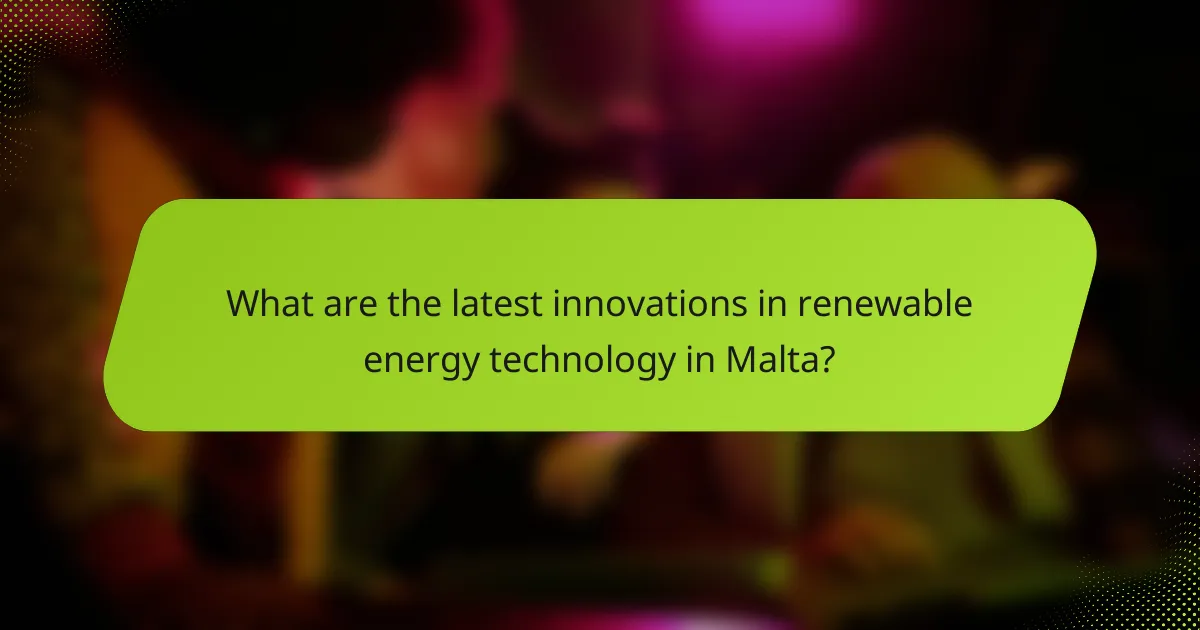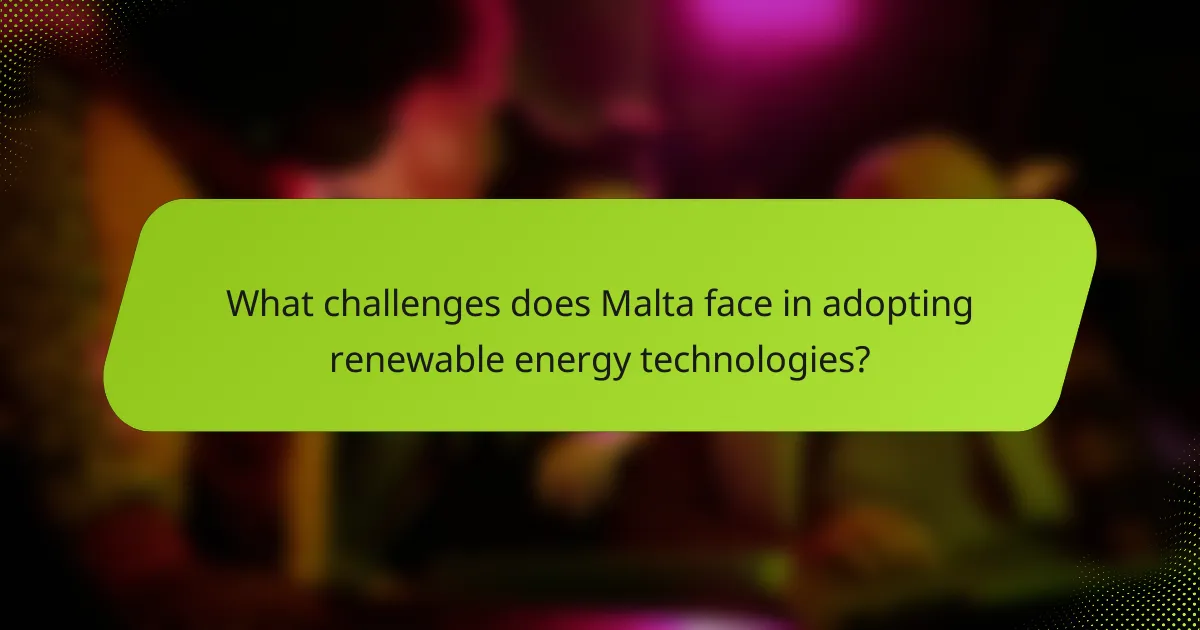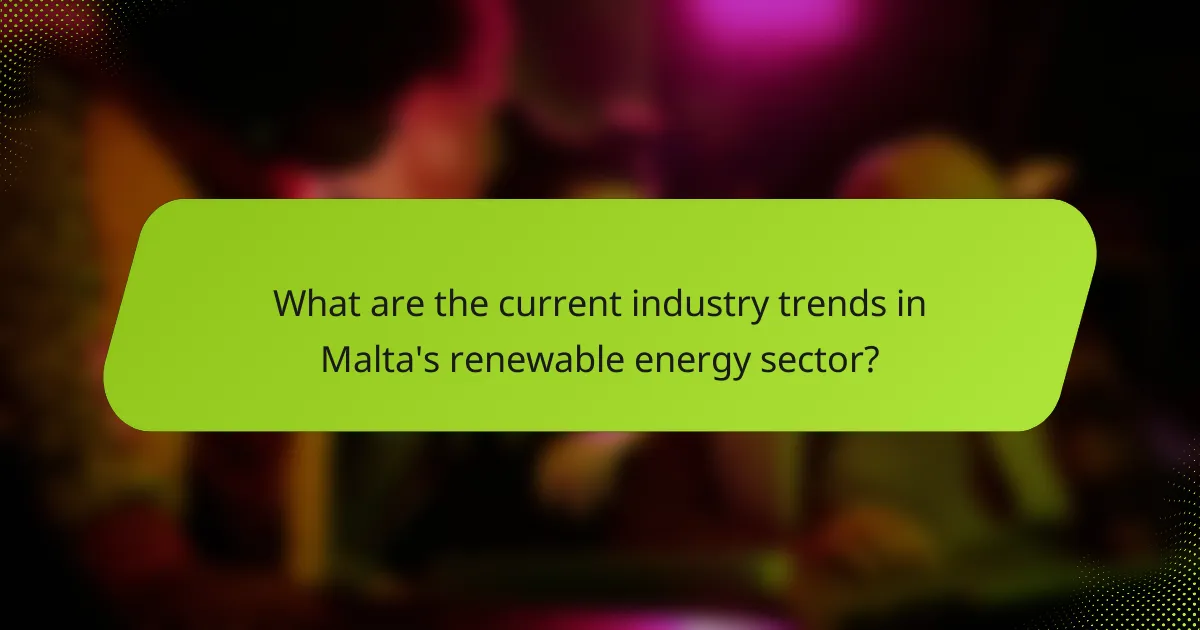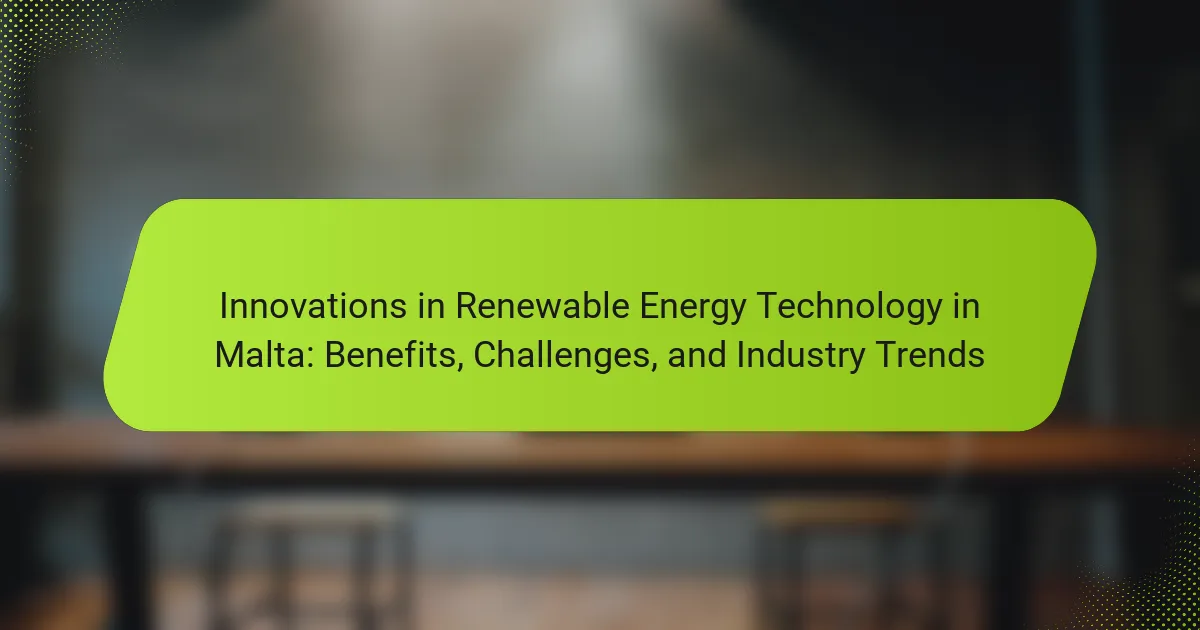
What are the latest innovations in renewable energy technology in Malta?
Malta has recently implemented several innovations in renewable energy technology. One significant advancement is the integration of solar power systems with energy storage solutions. These systems allow for the efficient use of solar energy, even during non-sunny hours.
Another innovation is the development of offshore wind energy projects. These projects aim to harness wind energy in deeper waters, where wind speeds are higher. Additionally, Malta is investing in smart grid technology. This technology enhances energy management and distribution, improving overall efficiency.
Research by the Malta Chamber of Commerce highlights these advancements. The report indicates that renewable energy contributed to 10% of Malta’s total energy consumption in 2022. This marks a significant increase from previous years, showcasing the effectiveness of these innovations.
How are these innovations reshaping the energy landscape in Malta?
Innovations in renewable energy technology are significantly reshaping the energy landscape in Malta. These advancements include the integration of solar energy systems and wind power solutions. The increase in solar panel installations has led to a rise in clean energy production. As of 2022, solar energy accounted for approximately 12% of Malta’s total energy generation. Wind energy projects are also being developed, contributing to a more diversified energy mix. The government supports these initiatives through incentives and policies promoting renewable energy adoption. This shift reduces reliance on imported fossil fuels, enhancing energy security. Additionally, innovations in energy storage technology improve the reliability of renewable sources. Overall, these changes foster a more sustainable and resilient energy framework in Malta.
What specific technologies are being implemented in Malta’s renewable energy sector?
Malta’s renewable energy sector is implementing solar photovoltaic (PV) technology, wind energy systems, and biomass energy solutions. Solar PV technology harnesses sunlight to generate electricity. This technology has seen significant growth, with over 12 MW of installed capacity as of 2022. Wind energy systems are being developed to utilize Malta’s coastal winds for power generation. The government aims to increase wind energy capacity to 10% of total energy production. Biomass energy solutions involve converting organic materials into energy, contributing to waste management and energy production. These technologies reflect Malta’s commitment to increasing renewable energy sources and reducing carbon emissions.
How do these technologies compare to traditional energy sources?
Renewable energy technologies offer distinct advantages over traditional energy sources. They produce little to no greenhouse gas emissions, significantly reducing environmental impact. For instance, solar and wind energy systems have lower lifecycle emissions compared to fossil fuels. Additionally, renewable technologies often have lower operational costs once installed. A report by the International Renewable Energy Agency (IRENA) indicates that solar energy costs have decreased by 89% since 2009. Moreover, renewable energy sources are inexhaustible, unlike finite fossil fuels. This transition enhances energy security by diversifying energy supply. In Malta, adopting renewable technologies can lead to greater energy independence and sustainability.
What benefits do these innovations bring to Malta?
Innovations in renewable energy technology bring multiple benefits to Malta. They enhance energy security by reducing reliance on imported fossil fuels. This shift contributes to lower energy costs for consumers and businesses alike. Additionally, these innovations promote environmental sustainability through reduced greenhouse gas emissions. Malta can also expect job creation in the renewable energy sector, fostering economic growth. Enhanced energy efficiency is another key benefit, leading to reduced energy consumption. Furthermore, these technologies can improve the resilience of Malta’s energy infrastructure against climate change impacts. Overall, the adoption of renewable energy innovations supports Malta’s transition to a sustainable energy future.
How do these technologies contribute to environmental sustainability?
Renewable energy technologies contribute to environmental sustainability by reducing greenhouse gas emissions. These technologies, such as solar and wind power, generate energy without burning fossil fuels. According to the International Renewable Energy Agency, renewable energy sources can lower carbon dioxide emissions by up to 70%. Additionally, they help conserve natural resources by relying on infinite sources like sunlight and wind. Implementing these technologies can also lead to improved air quality, as they produce little to no air pollutants. Furthermore, the use of renewable energy can enhance energy security and reduce dependence on imported fuels. This shift supports local economies and promotes sustainable development.
What economic advantages do renewable energy innovations provide?
Renewable energy innovations provide significant economic advantages. They reduce dependence on imported fossil fuels, which lowers energy costs. For example, Malta has seen a decrease in energy prices due to increased solar energy adoption. Job creation is another advantage, with the renewable sector offering new employment opportunities. Research indicates that the renewable energy sector can create three times more jobs than fossil fuels per unit of electricity generated. Additionally, renewable energy systems often lead to lower operational and maintenance costs over time. Investments in renewables can stimulate local economies and promote energy independence. Overall, these innovations contribute to sustainable economic growth and resilience.

What challenges does Malta face in adopting renewable energy technologies?
Malta faces several challenges in adopting renewable energy technologies. Limited land availability restricts the installation of large-scale renewable projects. The small size of the island leads to high initial costs for infrastructure development. Additionally, the existing energy grid requires upgrades to accommodate renewable sources. Regulatory hurdles can slow down the implementation of new technologies. Public awareness and acceptance of renewable energy solutions are still developing. Malta’s dependency on fossil fuels creates resistance to change. Lastly, financial incentives for renewable energy projects are often insufficient to attract investment.
What are the regulatory barriers to renewable energy implementation?
Regulatory barriers to renewable energy implementation include complex permitting processes. These processes can delay project approvals and increase costs. Additionally, inconsistent policies across regions create uncertainty for investors. Lack of grid access for renewable projects further complicates implementation. Financial incentives may be insufficient or poorly structured, discouraging investment. Compliance with outdated regulations can hinder innovation in technology. Lastly, limited public awareness and engagement can affect policy support. These factors collectively impede the growth of renewable energy initiatives.
How do these regulations impact the growth of the renewable energy sector?
Regulations significantly impact the growth of the renewable energy sector by providing a structured framework for development. These regulations can incentivize investment through tax credits and subsidies. They also set standards for emissions and energy efficiency, guiding technological advancements. Compliance with regulations can enhance the credibility of renewable energy projects. In Malta, specific policies have encouraged the adoption of solar energy, leading to increased installations. According to the Malta Environment and Planning Authority, renewable energy sources accounted for 10% of the total energy consumption in 2020. This growth is directly linked to supportive regulatory measures. Therefore, effective regulations foster a conducive environment for innovation and expansion in the renewable energy sector.
What technical challenges are present in integrating renewable technologies?
Integrating renewable technologies presents several technical challenges. One major challenge is the intermittency of renewable energy sources like solar and wind. These sources produce energy only when conditions are favorable, leading to fluctuations in power supply.
Another challenge is the need for advanced energy storage solutions. Current battery technologies may not provide sufficient capacity or efficiency to store energy for extended periods.
Grid compatibility is also a significant issue. Many existing energy grids are not designed to handle the variable input from renewable sources. This can lead to stability problems and require upgrades to infrastructure.
Additionally, there are challenges related to the integration of renewable technologies into existing systems. This includes the need for smart grid technology to manage energy distribution effectively.
Regulatory and technical standards can also pose obstacles. Ensuring compliance with safety and performance standards requires ongoing collaboration among stakeholders.
Finally, the upfront costs associated with integrating renewable technologies can be a barrier. Investment in new systems and technologies is often required before realizing long-term savings.
How does public perception affect renewable energy initiatives in Malta?
Public perception significantly influences renewable energy initiatives in Malta. Positive public sentiment can lead to increased support for government policies promoting renewable energy. This support often translates into funding and resources for projects. Conversely, negative perceptions can result in public opposition to renewable energy developments. For instance, concerns about land use and visual impact can hinder project approvals. Surveys indicate that public awareness campaigns improve acceptance of renewable technologies. As a result, effective communication strategies are essential for fostering public support. Overall, public perception shapes the landscape of renewable energy initiatives in Malta.
What are common misconceptions about renewable energy technologies?
Common misconceptions about renewable energy technologies include the belief that they are unreliable and inefficient. Many people think renewable energy sources cannot provide consistent power. However, advancements in energy storage and grid management have significantly improved reliability.
Another misconception is that renewable technologies are too expensive. The cost of solar and wind energy has decreased dramatically over the past decade. According to the International Renewable Energy Agency (IRENA), solar energy costs fell by 82% between 2010 and 2019.
Some also believe that renewable energy cannot meet global energy demands. In reality, studies show that renewables could supply up to 80% of global energy needs by 2050.
Additionally, there is a notion that renewable energy technologies require excessive land. While some installations do need space, innovative solutions like offshore wind farms and solar panels on rooftops minimize land use.
Lastly, many assume that renewable technologies are not environmentally friendly. In fact, they produce significantly lower emissions compared to fossil fuels. This makes them a crucial part of combating climate change.
How can public awareness be improved to support these innovations?
Public awareness can be improved through targeted educational campaigns. These campaigns should focus on the benefits of renewable energy technologies. Workshops and seminars can engage the community directly. Collaborating with local schools can raise awareness among students. Social media platforms can disseminate information rapidly and widely. Community events can showcase innovations in renewable energy. Government support can amplify these initiatives through funding and resources. Studies show that informed communities are more likely to adopt renewable technologies, as seen in various successful global initiatives.

What are the current industry trends in Malta’s renewable energy sector?
Malta’s renewable energy sector is currently focused on increasing solar energy adoption and energy efficiency. The government has implemented incentives for solar panel installations, leading to a rise in residential and commercial applications. Wind energy projects are also being explored, although they remain less developed compared to solar. Energy storage solutions are gaining attention, enhancing the reliability of renewable sources. Additionally, there is a push for integrating smart grid technologies to optimize energy distribution. The sector is witnessing collaboration between public and private entities to foster innovation. Overall, Malta aims to achieve its renewable energy targets in line with EU directives.
How is Malta positioning itself in the broader renewable energy market?
Malta is positioning itself as a competitive player in the broader renewable energy market through various strategic initiatives. The government aims to increase the share of renewables in its energy mix to 20% by 2020, as outlined in its National Energy and Climate Plan. Investments in solar energy have surged, making Malta one of the leading countries in solar panel installations per capita in Europe. Additionally, Malta is exploring offshore wind energy potential, which could further diversify its renewable sources. The country is also collaborating with EU partners to access funding and technology for renewable projects, enhancing its market presence. These efforts are supported by local policies promoting energy efficiency and sustainability, which align with EU climate goals. Malta’s commitment to renewable energy is evident in its participation in international energy forums and agreements, showcasing its dedication to a sustainable energy future.
What partnerships are being formed to enhance renewable energy initiatives?
Partnerships are being formed between government entities, private companies, and research institutions to enhance renewable energy initiatives. In Malta, the government collaborates with local businesses to promote solar energy projects. The Malta Chamber of Commerce is also involved in initiatives to support wind energy development. Additionally, universities are partnering with energy firms to innovate in energy storage solutions. These collaborations aim to increase investment in renewable technologies. They focus on improving energy efficiency and reducing carbon emissions. The European Union provides funding to support these partnerships, further encouraging growth in the renewable sector.
How is innovation driving competition in Malta’s energy sector?
Innovation is driving competition in Malta’s energy sector by fostering new technologies and improving efficiency. The introduction of renewable energy sources, such as solar and wind, has increased market participation. Companies are investing in smart grid technologies to enhance energy management. This shift encourages lower energy prices for consumers. Additionally, government incentives support research and development in clean energy. The competitive landscape is further enhanced by startups focusing on energy storage solutions. These advancements lead to a more sustainable energy future for Malta. Overall, innovation is reshaping the energy market dynamics significantly.
What role does research and development play in Malta’s renewable energy future?
Research and development (R&D) is crucial for Malta’s renewable energy future. R&D drives innovation in energy technologies, enabling the country to explore efficient solutions. It helps in identifying renewable resources suitable for Malta’s unique geographic conditions. Additionally, R&D facilitates the development of energy storage systems, improving reliability and efficiency.
The Maltese government has invested in R&D initiatives to enhance solar and wind energy capabilities. For example, the University of Malta conducts research on photovoltaic systems, aiming to increase energy output. Collaborations with international organizations also bolster local expertise and technology transfer.
Ultimately, R&D fosters sustainable practices, contributing to Malta’s goal of reducing carbon emissions by 2030. This focus on innovation is essential for meeting future energy demands and achieving energy independence.
What institutions are leading research in renewable energy technologies?
The leading institutions in renewable energy research include the Massachusetts Institute of Technology (MIT), Stanford University, and the National Renewable Energy Laboratory (NREL). MIT focuses on solar energy, energy storage, and smart grid technologies. Stanford University conducts research on biofuels, solar energy, and energy efficiency. NREL specializes in solar, wind, and geothermal energy technologies. These institutions are recognized for their significant contributions to advancing renewable energy solutions. Their research often influences policy and industry practices globally.
How are local innovations contributing to global renewable energy solutions?
Local innovations are enhancing global renewable energy solutions by introducing unique technologies and practices. For example, Malta has developed advanced solar energy systems tailored to its climate. These systems optimize energy capture and efficiency. Additionally, local innovations in energy storage are improving the reliability of renewable sources. Research indicates that such innovations can significantly reduce costs and increase accessibility. According to a report by the International Renewable Energy Agency, localized solutions can lead to a 20% increase in renewable energy adoption. Local innovations also foster community engagement and awareness, driving further adoption globally.
What practical steps can Malta take to enhance its renewable energy efforts?
Malta can enhance its renewable energy efforts by increasing investment in solar and wind energy infrastructure. Expanding solar panel installations can significantly boost energy generation. Wind energy projects can be developed to harness Malta’s coastal winds. Additionally, Malta should incentivize energy efficiency measures for businesses and households. Implementing smart grid technology can optimize energy distribution and consumption. Promoting public awareness campaigns on renewable energy benefits can drive community engagement. Collaborating with EU initiatives can provide funding and technical support for renewable projects. Lastly, establishing regulatory frameworks can facilitate the growth of the renewable energy sector.
What best practices can be adopted from other countries’ experiences?
Countries like Germany and Denmark have successfully implemented renewable energy policies. Malta can adopt their feed-in tariff systems to incentivize solar energy production. Germany’s Energiewende initiative demonstrates effective integration of renewable sources into the national grid. Denmark’s wind energy model shows the benefits of community involvement in renewable projects. These countries have also invested in energy storage solutions, enhancing grid reliability. Furthermore, public awareness campaigns in these nations have increased citizen participation in energy conservation. Research indicates that these practices have led to significant reductions in carbon emissions and increased energy independence. Adopting similar strategies could benefit Malta’s renewable energy sector.
How can stakeholders collaborate to overcome existing challenges?
Stakeholders can collaborate to overcome existing challenges in renewable energy technology by forming strategic partnerships. These partnerships can facilitate resource sharing and knowledge exchange. For instance, government entities can work with private companies to align policies with industry needs. Academic institutions can contribute research and innovation to enhance technological advancements. Collaborative projects can also attract funding and investment, which is crucial for development. Regular communication among stakeholders ensures that challenges are identified and addressed promptly. Joint initiatives can lead to shared goals, enhancing the overall effectiveness of renewable energy solutions. Successful collaborations have been observed in various countries, demonstrating the potential for improved outcomes through collective effort.
The main entity of this article is renewable energy technology innovations in Malta. The article examines recent advancements such as solar power systems with energy storage, offshore wind energy projects, and smart grid technology, which collectively enhance energy efficiency and sustainability. It highlights the benefits of these innovations, including reduced reliance on fossil fuels, lower energy costs, and job creation, while also addressing challenges like regulatory barriers and public perception. Additionally, the article explores industry trends and the role of research and development in shaping Malta’s renewable energy future.
